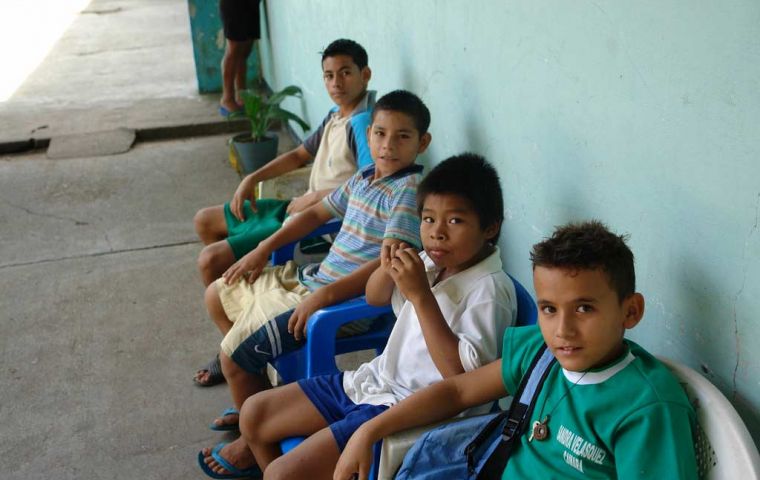MercoPress. South Atlantic News Agency
Unicef says Brazil has 32mn children and adolescents in poverty
 Chopitea said there are children in Brazil who have not returned to school after the Covid-19 lockdowns
Chopitea said there are children in Brazil who have not returned to school after the Covid-19 lockdowns According to the United Nations Children's Fund (Unicef), 63% of Brazil's boys and girls live in poverty, which is tantamount to around 32 million children and adolescents, Agencia Brasil reported.
The global agency based its calculations on the South American country's National Household Sample Survey measuring poverty in income, food, education, child labor, housing, water, sanitation, and information.
The study on Multiple Dimensions of Poverty in Childhood and Adolescence in Brazil featured data collected until 2019 (child labor, housing, water, sanitation, and information), until 2021 (income and food), and until 2022 (education). “At this time when the president, vice president, ministers, governors, senators, and deputies start new terms in office, UNICEF alerts to the urgency of prioritizing public policies with sufficient resources aimed at children and adolescents in the country,” the international office noted.
The research highlights that poverty in childhood and adolescence goes beyond income and includes aspects such as being out of school, living in precarious housing, not having access to water and sanitation, not having adequate food, child labor, and not having access to information, factors that are considered deprivations and that cause so many boys and girls to be inserted in this multidimensional poverty context.
The report used data from the National Household Sample Survey (Pnad Contínua) and the results revealed a worrisome scenario: the last year for which information is available for all eight indicators was 2019 when there were 32 million girls and boys up to 17 years old deprived of one or more of these rights. For subsequent years, data is only available for income, food, and education - and all three have worsened.
In 2021, the percentage of children and adolescents living in families with incomes below the extreme monetary poverty line (less than US$ 1.9 per day) reached the highest level in the last 5 years: 16.1%, up from 13.8% in 2017.
The number of minors deprived of the income necessary for adequate nutrition rose from 9.8 million in 2020 to 13.7 million in 2021, a jump of almost 40%. In education, meanwhile, after years of decline, the illiteracy rate doubled from 2020 to 2022 - going from 1.9% to 3.8%.
“Multidimensional poverty impacted more those who already lived in more vulnerable situations - black and indigenous people and residents of the North and Northeast regions - worsening inequalities in the country. Among black and indigenous children and adolescents, 72.5% were in multidimensional poverty in 2019, versus 49.2% of whites and yellows. Among states, six had more than 90% of children and adolescents in multidimensional poverty, all in the North and Northeast.”
Among the main deprivations impacting childhood and adolescence, according to UNICEF, are lack of access to basic sanitation (reaching 21.2 million girls and boys), followed by income deprivation (20.6 million) and access to information (6.2 million). Added to these are the lack of adequate housing (4.6 million), lack of education (4.3 million), lack of access to water (3.4 million), and child labor (2.1 million).
Unicef's guidelines for Brazil include prioritizing investments in social policies; expanding the supply of services and benefits to the most vulnerable children and adolescents; strengthening the System to Guarantee the Rights of Children and Adolescents; promoting food and nutritional security for pregnant women, children, and adolescents; implementing policies for active school search and resumption of learning, especially in literacy; and prioritizing the water and sanitation agenda.
Liliana Chopitea, head of Social Policies, Monitoring and Evaluation, and South-South Cooperation of UNICEF in Brazil, found that multidimensional poverty is different from the traditional poverty concept. “It is the result of the interaction between deprivations and exclusions to which children and adolescents are exposed.”
“The data show structural challenges and that regional, racial, and gender inequalities, unfortunately, persist in Brazil, despite all the efforts made in recent decades,” she assessed. “The scenario became even more challenging during and after the pandemic,” she added, citing the worsening in indicators such as income, food, and education in the period from 2020 to 2022.
Chopitea also recalled that Brazil was one of the countries that remained for the longest time with schools closed due to Covid-19. She also underlined that some Brazilian children have not yet returned to school. “Illiteracy is one of the dimensions of great concern, reaching 3.1% of children and adolescents in 2020.”
“It is very important to prioritize investments in social policies,” she said. “It is important that there be measurement and monitoring of the different dimensions of poverty and its deprivations by an official state body. And that it be done periodically,” she added while highlighting the adoption of ways to early detect vulnerable families and the promotion and strengthening of opportunities in the school environment. (Source: Agencia Brasil)




Top Comments
Disclaimer & comment rulesCommenting for this story is now closed.
If you have a Facebook account, become a fan and comment on our Facebook Page!